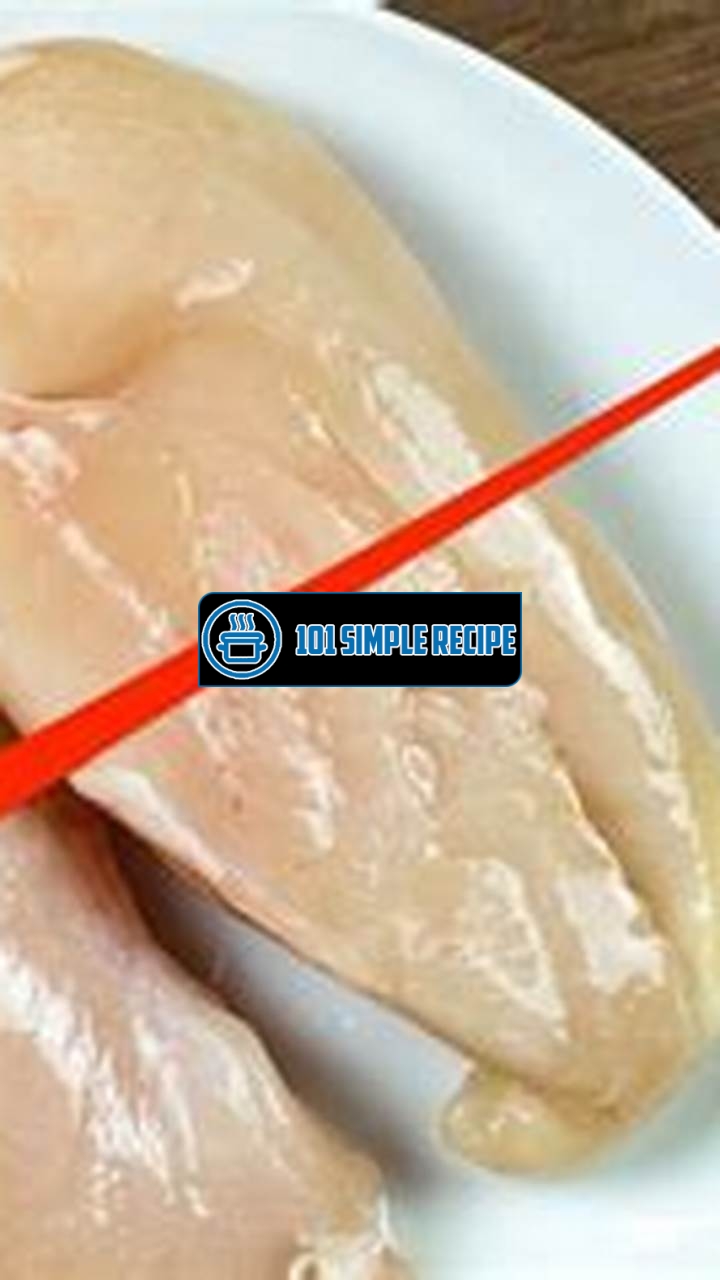If you’re ready to level up your culinary skills and master the art of cooking chicken breast, one of the essential techniques to learn is how to remove the tendon. This small, tough piece of tissue can make the chicken texture less enjoyable if left intact. Therefore, in this article, we will guide you through the step-by-step process of removing the tendon from a chicken breast. With our simple instructions and visual aids, you’ll soon be able to effortlessly prepare tender and delicious chicken dishes. So, grab your knife and let’s get started on this culinary journey!

Preparing the Chicken Breast
Before you can remove the tendon from a chicken breast, it’s important to go through a few initial steps. These steps will ensure that the chicken breast is clean, trimmed, tenderized, and sliced properly. Let’s dive into each of these steps in detail.
Cleaning and Trimming the Chicken Breast
The first step in preparing the chicken breast is to clean and trim it. Start by rinsing the chicken breast under cold water to remove any dirt or debris. Pat it dry with a paper towel and place it on a clean cutting board. Now, take a pair of kitchen shears or a sharp knife and carefully remove any excess fat or skin from the chicken breast.
Note: It’s important to handle raw chicken with caution to prevent cross-contamination. Use separate cutting boards and utensils for raw chicken and other ingredients.
Important point: Make sure to discard the trimmings properly and wash your hands thoroughly after handling raw chicken.
Tenderizing the Chicken Breast
Tenderizing the chicken breast helps to break down the muscle fibers, making it more tender and juicy when cooked.
There are several ways to tenderize chicken breast:
- Using a meat mallet or rolling pin: Place the chicken breast between plastic wrap or a zip-top bag and gently pound it with a meat mallet or rolling pin until it becomes even in thickness. This process helps to tenderize the meat and ensures even cooking.
- Marinating: Another way to tenderize the chicken breast is by marinating it in a mixture of acidic ingredients like lemon juice, vinegar, or yogurt. The acid helps to break down the proteins in the meat, resulting in a tender and flavorful chicken breast.
- Using a meat tenderizer: A meat tenderizer, also known as a meat tenderizing tool or a Jaccard, is a device with multiple small, sharp blades. Press the tool onto the chicken breast, allowing the blades to penetrate the meat and create tiny cuts. This process helps to tenderize the chicken breast.
Important point: Choose the tenderizing method that suits your preference and the time you have available. Marinating the chicken overnight will result in the most tender and flavorful outcome.
Slicing the Chicken Breast
Once you have cleaned, trimmed, and tenderized the chicken breast, it’s time to slice it. Slicing the chicken breast properly ensures that it cooks evenly and results in a consistent texture.
To slice the chicken breast:
- Place the chicken breast on a cutting board and hold it firmly with one hand.
- Using a sharp knife, start slicing the chicken breast horizontally to create thin, even slices. Alternatively, you can slice it into chunks or cubes, depending on your recipe.
- Continue slicing until you have cut the entire chicken breast.
Important point: Take caution when handling sharp objects, and make sure to keep your fingers away from the blade while slicing the chicken breast.
By following these steps, you will be well on your way to removing the tendon from a chicken breast and preparing it for cooking. Remember to handle raw chicken with care, practice proper hygiene, and enjoy the delicious results of your efforts!
The Importance of Removing the Tendon
When it comes to cooking chicken breast, removing the tendon is not just a matter of preference – it’s essential for a better dining experience. By understanding the reasons behind removing the tendon, you can elevate the texture, tenderness, and flavor absorption of this popular cut of meat. Additionally, removing the tendon helps prevent choking hazards, ensuring a safe meal for you and your loved ones.
Improving Texture and Tenderness
Removing the tendon plays a crucial role in improving the texture and tenderness of chicken breast. The tendon, which runs through the center of the breast, can be tough and chewy when cooked. By taking the time to remove it, you can ensure each bite of chicken breast is tender, juicy, and easy to chew. This attention to detail will undoubtedly elevate your dining experience.
To remove the tendon, start by identifying its location. It usually runs along the center, dividing the breast into two halves. Gently slice along the tendon until you can lift it away from the meat. Use your fingers or a knife to carefully separate the tendon from the chicken breast, taking care not to tear the meat. Once the tendon is completely removed, you can proceed with cooking the chicken breast to perfection.
Enhancing Flavor Absorption
Another important reason to remove the tendon is to enhance the absorption of flavors. When marinating or seasoning chicken breast, the flavors penetrate the meat more effectively when the tendon is removed. Without this barrier, the flavors can fully infuse the meat, resulting in a more delicious and enjoyable dish. Whether you’re using savory herbs and spices or a tangy marinade, removing the tendon ensures a flavor-packed chicken breast.
To maximize flavor absorption, consider marinating the chicken breast for at least 30 minutes before cooking. This will allow the flavors to penetrate the meat even further, resulting in a mouthwatering dish. Remember to properly season the chicken breast with your desired spices, herbs, or marinade before cooking to take full advantage of the enhanced flavor absorption.
Preventing Choking Hazards
Removing the tendon from chicken breast is also crucial for preventing choking hazards. The tendon can be tough and stringy, posing a risk, especially for children or individuals who have difficulty swallowing. By taking the time to remove the tendon, you minimize the chances of any unpleasant situations while enjoying your meal.
It’s important to note that cutting the chicken breast into smaller pieces after removing the tendon also helps reduce choking hazards. By cutting the meat into bite-sized portions, you create a safer eating experience for everyone, especially if you have young children or elderly individuals at the table.
Note: Removing the tendon not only improves texture, tenderness, and flavor absorption but also ensures a safer dining experience by minimizing choking hazards. Take the extra step to remove the tendon, and you’ll be rewarded with a delicious and worry-free chicken breast meal.
In conclusion, removing the tendon from chicken breast is of utmost importance for a better dining experience. By understanding the reasons behind it, such as improving texture and tenderness, enhancing flavor absorption, and preventing choking hazards, you can elevate the quality of your chicken breast dishes. Remember, it’s not just about taste but also about creating a safe and enjoyable meal for yourself and your loved ones.
Identifying the Tendon
When it comes to removing the tendon from a chicken breast, the first step is to properly identify its location. This can be done effectively through visual inspection, tactile examination, and the use of kitchen tools.
Visual Inspection of the Chicken Breast
A visual inspection is the starting point in identifying the tendon in a chicken breast. Look closely at the breast and pay attention to any white, sinewy tissue running through it. This tissue is the tendon that needs to be removed. Remember to look for it both on the surface and within the meat, as it can be hidden beneath the skin or fat.
Note: Identifying the tendon visually may require good lighting and a keen eye.
Tactile Examination of the Chicken Breast
The next step involves a tactile examination. Gently feel the chicken breast with your fingers, applying slight pressure. Look for any areas that feel tougher or more rigid compared to the surrounding meat. These firm areas are indicative of the presence of the tendon.
Note: The tendon will feel distinct from the surrounding meat, providing a noticeable difference in texture and resistance.
Using Kitchen Tools to Locate the Tendon
If visual inspection and tactile examination do not clearly reveal the tendon, you can rely on various kitchen tools to assist you further. Tools such as a paring knife, boning knife, or even tweezers can be beneficial in locating and removing the tendon.
Note: Exercise caution when using sharp kitchen tools to avoid injury. Always handle knives with care and keep them away from children.
To use a paring knife or boning knife, start by making a small incision along the length of the tendon. Be careful not to cut too deep into the chicken breast. Once the incision is made, gently lift the tendon with the tip of the knife or use your fingers to pull it out.
Tweezers can also be handy in removing the tendon. Grasp the end of the tendon firmly with the tweezers and gently pull it out in a steady motion.
Note: Pay attention to the size and shape of the tendon as you remove it. This will help you identify it more easily in the future.
By effectively identifying the location of the tendon in a chicken breast through visual inspection, tactile examination, and the use of kitchen tools, you can successfully remove it and enjoy tender, delicious chicken that is free from any unwanted sinew.
Tools and Techniques for Tendon Removal
When it comes to removing tendons from chicken breasts, having the right tools and techniques at your disposal can make the process much easier. In this article, we will explore various methods and tools that you can use to effectively remove tendons from chicken breasts.
Using Kitchen Shears
One of the most popular tools for removing tendons from chicken breasts is a pair of kitchen shears. These shears are designed specifically for cutting through meat and bones, making them ideal for this task. To use kitchen shears, follow these steps:
- Start by rinsing the chicken breast under cold water and patting it dry with a paper towel.
- Locate the tendon in the chicken breast. It will appear as a thin, white, elastic-like strip running through the meat.
- Hold the chicken breast firmly with one hand and use the shears to carefully cut alongside the tendon, removing it from the meat. It’s important to be precise and avoid cutting too much of the meat.
- Once the tendon is removed, inspect the chicken breast to ensure that no bits of tendon remain.
Using kitchen shears allows for quick and efficient tendon removal, giving you a clean and tender chicken breast for your recipe.+
Utilizing a Knife for Precision
Another technique for removing tendons from chicken breasts is to use a sharp knife. This method provides more precision but requires a steady hand. Here’s how you can utilize a knife for tendon removal:
- Prepare the chicken breast by rinsing and drying it thoroughly.
- Identify the tendon in the chicken breast and carefully slice along one side of it, making a shallow incision. Be cautious not to cut too deep into the meat.
- Gently lift the tendon with your fingers or a pair of clean tweezers and use the knife to slowly and carefully cut it away from the surrounding meat.
- Inspect the chicken breast to ensure all tendon fragments have been removed.
Utilizing a knife grants you the ability to be more precise in removing tendons, resulting in a chicken breast that is free from any unwanted connective tissue.
Alternative Techniques for Tendon Removal
If you don’t have kitchen shears or a sharp knife on hand, there are still alternative methods you can use to remove tendons from chicken breasts. These include:
- Pulling method: Using your fingers, grip the end of the tendon and gently pull it away from the chicken breast. This technique works best for larger tendons that can be easily grasped.
- Pounding method: Place the chicken breast between two sheets of plastic wrap and use a meat mallet or rolling pin to gently pound the meat. This method helps to break down the tendons, making them easier to remove.
- Boiling method: Boiling the chicken breast before cooking can help soften the tendons, making them more accessible for removal. However, be cautious not to overcook the meat in the process.
While these alternative techniques may not offer the same level of precision as using kitchen shears or a knife, they can still be effective in removing tendons from chicken breasts.
With the right tools and techniques, removing tendons from chicken breasts can be a breeze. Whether you choose to use kitchen shears, a knife, or alternative methods, always remember to handle the chicken with care and adhere to proper food safety practices.
Best Practices for Removing the Tendon
When it comes to preparing chicken breast, removing the tendon is an important step to ensure a tender and appetizing dish. By following a few best practices, you can easily and successfully remove the tendon from chicken breast.
Working with Chilled Chicken Breast
Before you start removing the tendon, it’s crucial to work with chilled chicken breast. This helps in maintaining the structure and firmness of the meat, making it easier to identify and remove the tendon.
To ensure that the chicken breast is properly chilled, you can place it in the refrigerator for about 30 minutes before you begin the tendon removal process. This will also help in preventing any potential contamination.
Pro Tip: Chilled chicken breast is easier to work with and allows for better precision when removing the tendon.
Applying Even Pressure
When removing the tendon from chicken breast, it’s important to apply even pressure throughout the process. This ensures that the meat remains intact and avoids unnecessary damage.
To apply even pressure, you can use your fingers or a pair of kitchen tongs. Start by gently pressing down on one end of the tendon with your finger or tongs while firmly holding the other end with your other hand. Then, using a slow and steady motion, apply consistent pressure in one direction to gradually detach the tendon from the meat.
Pro Tip: Make sure to be patient and gentle while applying pressure to avoid tearing the meat or causing any injuries to yourself.
Taking Precautions to Avoid Injuries
Although the tendon removal process may seem simple, it’s essential to take certain precautions to ensure your safety and avoid any injuries.
First and foremost, make sure to use a clean and sharp knife. A dull knife can slip and cause accidents. Additionally, always keep your fingers and hands away from the blade while removing the tendon.
It’s also recommended to use a cutting board with a non-slip surface to prevent any accidents while handling the chicken breast.
Pro Tip: Practice proper knife handling techniques and always exercise caution when working with sharp objects.
To sum up, by following these best practices, you can easily remove the tendon from chicken breast and ensure a smooth and successful preparation process. Remember to work with chilled chicken breast, apply even pressure, and take necessary precautions to avoid any injuries. With these tips and tricks, you’ll be able to enjoy tender, delicious chicken breast in your favorite recipes.
Frequently Asked Questions
Here are some frequently asked questions about removing tendon from chicken breast:
| No. | Questions | Answers |
|---|---|---|
| 1. | What is the tendon in chicken breast? | The tendon in chicken breast is a tough, fibrous tissue that needs to be removed before cooking to ensure tenderness. |
| 2. | Why is it important to remove the tendon? | Removing the tendon will make the chicken breast more enjoyable to eat and prevent any unpleasant chewiness. |
| 3. | What is the best method to remove the tendon from chicken breast? | One of the best methods is to use a sharp knife to carefully cut along the side of the tendon and remove it with minimal waste. |
| 4. | Are there any alternative methods to remove the tendon? | Yes, some people prefer using kitchen shears or tweezers to remove the tendon. It’s a matter of personal preference and dexterity. |
| 5. | Can I cook chicken breast with the tendon still intact? | While it is possible to cook chicken breast with the tendon, it is highly recommended to remove it for a better eating experience. |
| 6. | What can I do with the tendon after removing it? | You can discard the tendon or use it for making stocks and broths to add flavor and nutrients. |
Closing Thoughts on Removing Tendon from Chicken Breast
Thank you for reading our guide on how to remove tendon from chicken breast. We hope this article has provided you with useful information and helpful tips. Removing the tendon is an essential step in preparing chicken breast for a delicious and tender meal. Remember to visit our site again for more cooking tips and recipes. Happy cooking!
Jump to Recipe
How to Remove Tendon from Chicken Breast

Learn the step-by-step process of removing tendon from chicken breast for a more enjoyable and tender eating experience.
- 4 chicken breasts
- sharp knife
- kitchen shears
- tweezers
- patience
- Place the chicken breast on a clean cutting board.
- Locate the tendon, which is a thin, white strip running through the center of the breast.
- Using a sharp knife, carefully cut along the side of the tendon to separate it from the breast.
- Gently pull the tendon away from the breast, using the knife or your fingers to help in the process.
- Continue until the tendon is completely removed.
- Repeat the process for the remaining chicken breasts.
- Once the tendons are removed, proceed with your desired cooking method.






